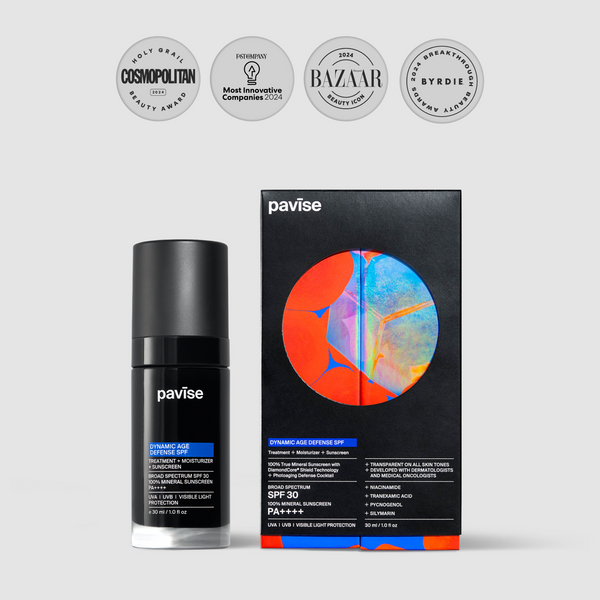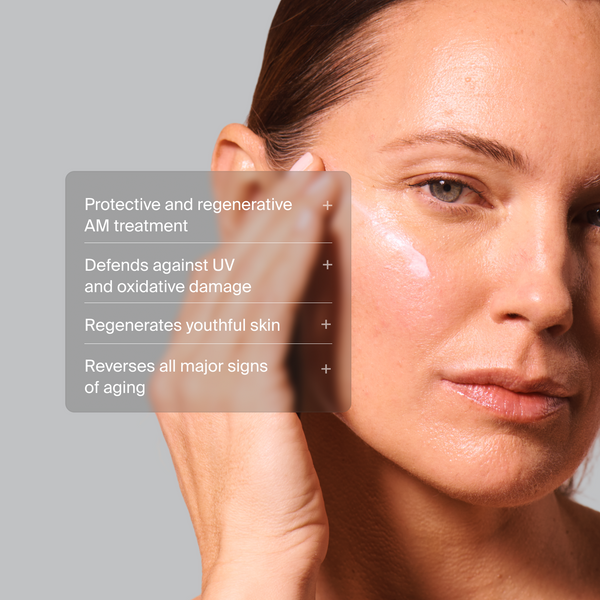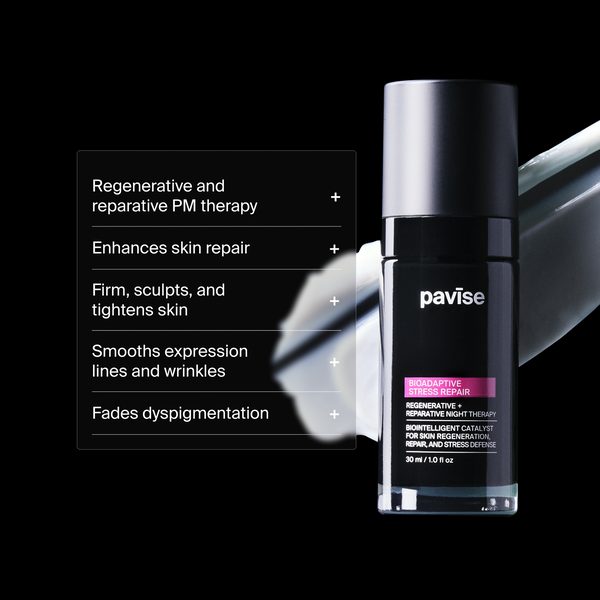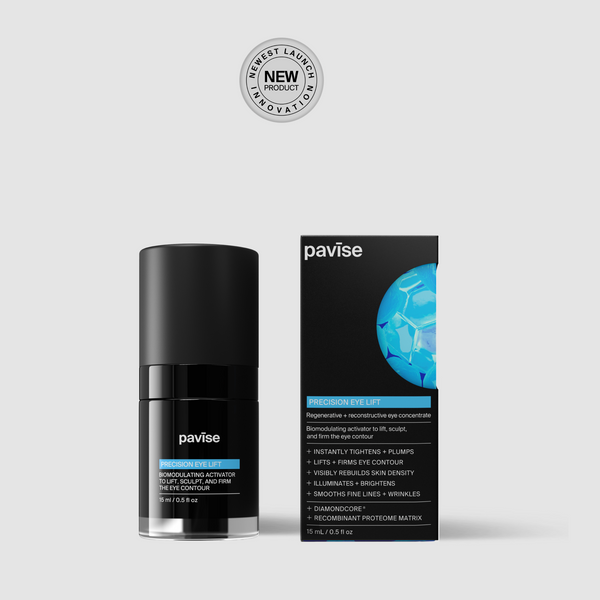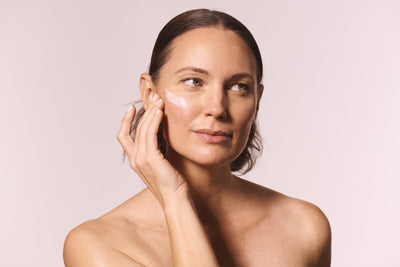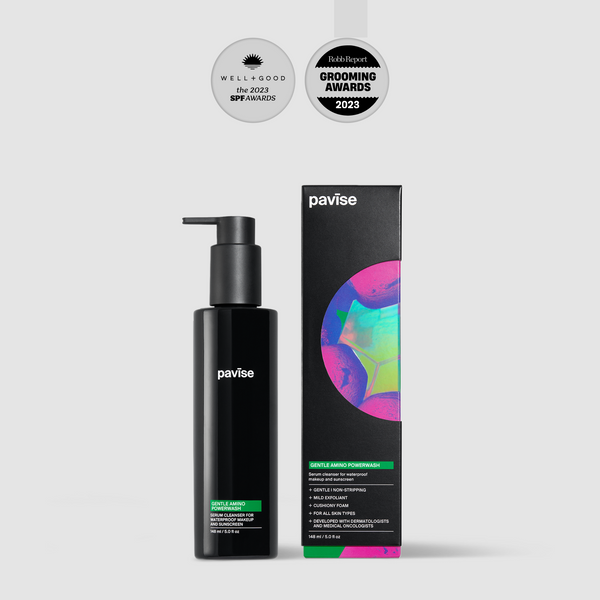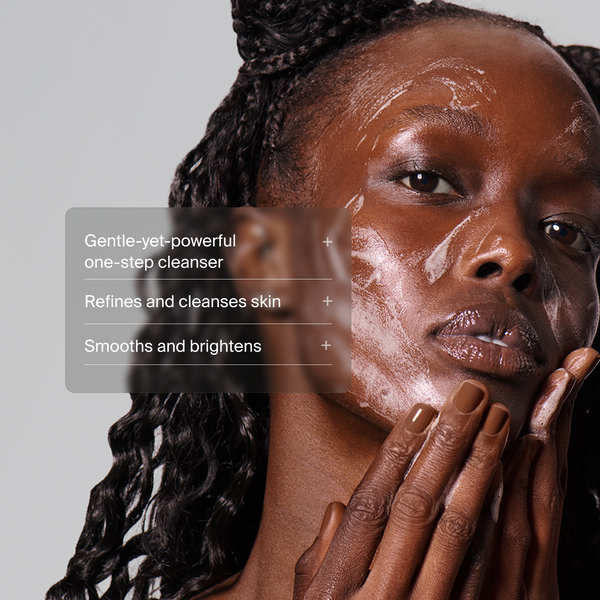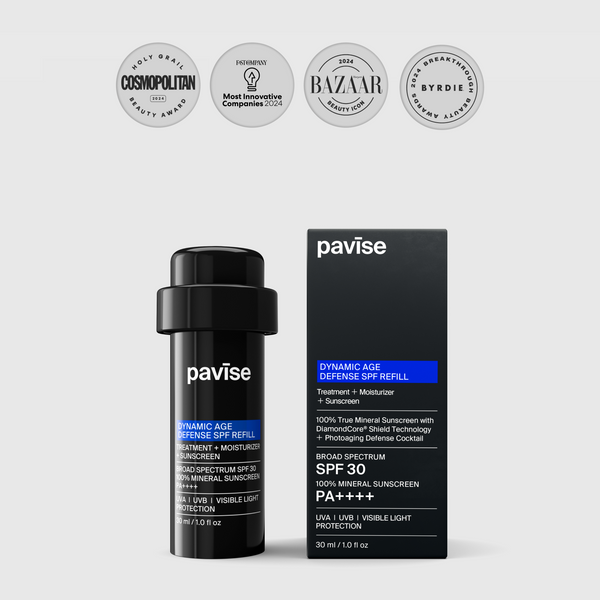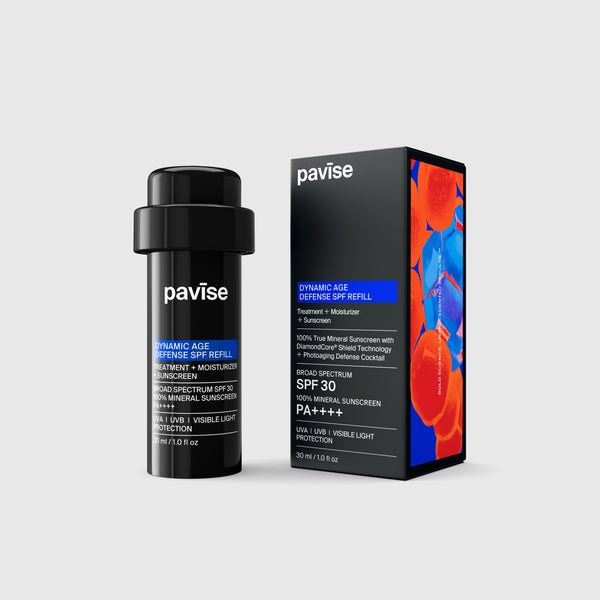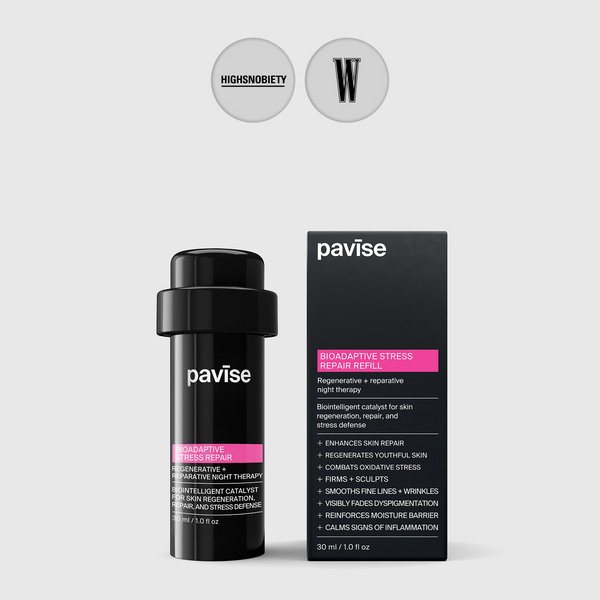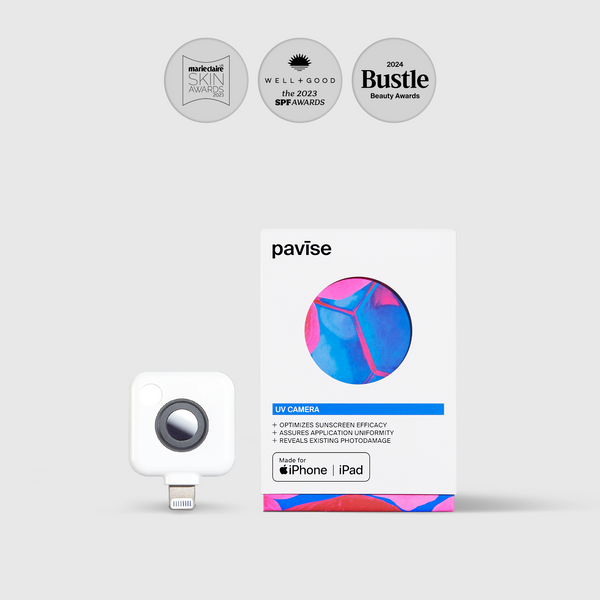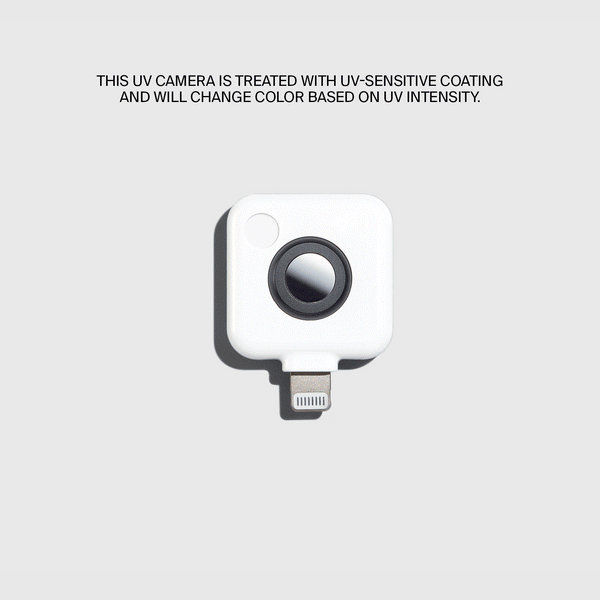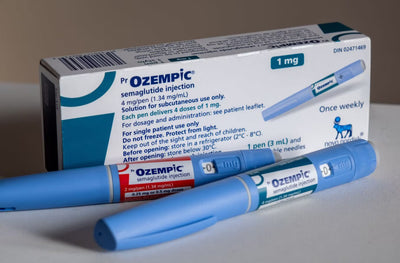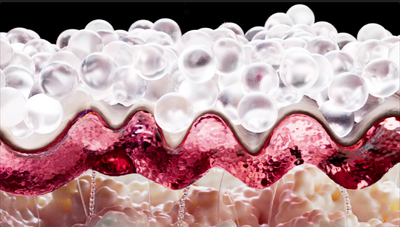CONSIDERATIONS FOR PERIORAL DERMATITIS
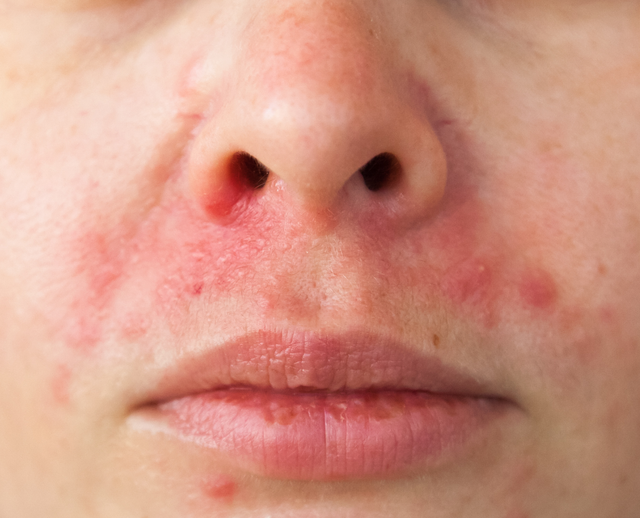
What you need to know
Perioral dermatitis can be caused by fragrances, skincare ingredients you might be allergic to, topical steroids, certain foods, and even sun exposure.
To manage perioral dermatitis, focus on avoiding triggers and using gentle, effective products that protect your skin barrier and prevent future post-inflammatory hyperpigmentation (PIH) and/or post-inflammatory erythema (PIE).
Both Dynamic Age Defense SPF, a 100% zinc oxide mineral sunscreen with high UVA protection, and Lip Defense SPF, a tinted lip oil free from allergenic pigments and hidden chemical UV filters, offer the most gentle and safe sun protection for those with perioral dermatitis.
Perioral dermatitis—and personalized recommendations on how to treat it—should be diagnosed by a dermatologist, but here’s what to look out for:4,5
- Inflammation that looks like acne or rosacea around the mouth
- Inflamed, discolored bumps often around the nose and mouth
- Burning, itching, and flaking on the lower half of the face
Once a flare-up or breakout has subsided, post-inflammatory hyperpigmentation (PIH) and/or post-inflammatory erythema (PIE) may appear. Perioral dermatitis can be caused by a variety of things, including fragrances, skincare ingredients you might be allergic to, topical steroids, certain foods, and even sun exposure.2 It most commonly occurs in women between 20 and 45 years of age.6
Identifying the causes and treating your specific brand of perioral dermatitis can be incredibly frustrating. The resulting PIH and PIE can take months or years to fade. It’s important to focus on eliminating the triggers of your perioral dermatitis and consistently using gentle but effective products that simultaneously protect your skin barrier and help to prevent future PIH/PIE.
How do you treat a perioral dermatitis flare-up?
A compromised skin barrier is characteristic of perioral dermatitis. First, eliminate unnecessary skincare and makeup steps. Start with products that contain more sensitizing ingredients like fragrances, exfoliants, retinol, and astringents.5,6 Other common topical triggers include fluoride-containing toothpaste, harsh surfactants found in cleansers like sodium lauryl sulfate, chemical sunscreens, titanium dioxide sunscreens, comedogenic makeup, and even topical steroids.2,6 Prioritize a simplified, gentle, and hydrating routine that consists of cleanser, moisturizer, and broad-spectrum sunscreen. This will encourage skin barrier repair and help to calm inflammation caused by solar and environmental stressors.
Second, pay attention to your skin’s reactions to other common perioral dermatitis lifestyle triggers, such as sun exposure, air pollution, stress, and hormone changes, and adjust accordingly.1,3 UV radiation and air pollution incite inflammatory responses in skin that can worsen itching and burning, degrade the skin’s moisture barrier, and exacerbate perioral dermatitis flare-ups. This is why sun protection is paramount in the treatment of perioral dermatitis. A quality sleep routine and anti-inflammatory diet may help to regulate stress and hormone triggers as well.
Third, focus on PIH/PIE prevention so that your latest flare-up leaves behind as few traces as possible. The gentlest and perhaps most effective way to do this is by using a sunscreen with high UVA protection. Most sunscreens prioritize UVB protection, the UV rays that SPF-values measure protection against (SPF30 protects against 97% of UVB rays, SPF50 protects against 98% of UVB rays). For those with perioral dermatitis, the UVA protection offered by general broad-spectrum sunscreens may not be preventative enough (learn why here). Instead, look for a sunscreen rated PA++++, the highest UVA protection rating given to sunscreens. This UVA protection factor test isn’t required of U.S. sunscreens, but it quantifies sunscreens’ level of UVA protection and ensures that you’re receiving the best defense against the UV rays that contribute most to the occurrence of PIH and PIE.
UVA rays make up 95% of all UV radiation, penetrate through clouds and glass, and penetrate deeper into the dermis than UVB rays. In the dermis, UVA rays encourage overproduction of melanin and inflammation, which manifest as PIH and PIE. UV damage, and really UVA damage, has also been cited as the root cause of 90% of visible skin change. Therefore, consistent use of sunscreen with high UVA protection is likely the best way to prevent PIH and PIE after a perioral dermatitis flare-up.
Why is Dynamic Age Defense SPF the best option for those with perioral dermatitis?
We’ve discussed how important sun protection is in helping to prevent UV-induced flare-ups and resulting PIH/PIE, but chemical sunscreens are a common flare-up trigger as they penetrate skin and tend to be more irritating. Dynamic Age Defense SPF is a 100% zinc oxide mineral sunscreen and doesn’t contain hidden chemical UV filters that can be found in the inactive ingredient lists of other “mineral” sunscreens. It is also free from titanium dioxide, a mineral sunscreen ingredient that can also trigger perioral dermatitis flare-ups in some. This makes Dynamic Age Defense SPF the safest sun protectant for reactive and inflammation-prone skin.
Dynamic Age Defense SPF is also the first 100% mineral sunscreen to have a PA++++ UVA protection rating. Earlier, we explained how important high UVA protection is for preventing post-flare-up PIH and PIE. By providing 100% mineral-based and superior UVA protection, Dynamic Age Defense SPF defends against the UV-induced inflammation that can trigger a flare-up and cause PIH/PIE.
Why is Lip Defense SPF the best tinted lip oil for those with perioral dermatitis?
Color cosmetics like lipsticks, lip glosses, and lip oils can be incredibly sensitizing for those with perioral dermatitis. They usually contain fragrances, synthetic dyes, lakes (ex. Red 7 Lake, Yellow 5 Lake), and other pigments that are irritating and allergenic. The epidermis, or top layer of skin on the lips, is also particularly thin, which increases the skin permeation potential of these common allergens. Other lip sunscreens also typically contain either hidden or FDA-registered chemical UV filters that are also sensitizing to those with perioral dermatitis.
Lip Defense SPF, like Dynamic Age Defense SPF, is a 100% mineral lip sunscreen formulated as a tinted lip oil and is also free from hidden chemical UV filters. It is also titanium dioxide, dye, and lake-free—a first in the industry. It’s pigmented entirely by iron oxides, naturally occurring mineral oxides that provide additional HEVL protection. Lip Defense SPF is PA++++, so it provides the best sun protection against perioral dermatitis-triggering UVA radiation. These qualities make Lip Defense SPF the safest, gentlest, and most effective protection for those with perioral dermatitis who aren’t quite ready to give up color cosmetics.
References:
- Araviiskaia, E., et al. “The Impact of Airborne Pollution on Skin.” Journal of the European Academy of Dermatology and Venereology, vol. 33, no. 8, Apr. 2019, https://doi.org/10.1111/jdv.15583.
- Diehl, Kyra L., and Philip R. Cohen. “Topical Steroid-Induced Perioral Dermatitis (TOP STRIPED): Case Report of a Man Who Developed Topical Steroid-Induced Rosacea-like Dermatitis (TOP SIDE RED).” Cureus, Apr. 2021, https://doi.org/10.7759/cureus.14443. Accessed 26 May 2021.
- Fadadu, Raj P., et al. “Air Pollution and Atopic Dermatitis, from Molecular Mechanisms to Population-Level Evidence: A Review.” International Journal of Environmental Research and Public Health, vol. 20, no. 3, Jan. 2023, pp. 2526–26, https://doi.org/10.3390/ijerph20032526. Accessed 24 July 2023.
- Gray, N. A., et al. “Pharmacological Interventions for Periorificial (Perioral) Dermatitis in Children and Adults: A Systematic Review.” Journal of the European Academy of Dermatology and Venereology, vol. 36, no. 3, Dec. 2021, pp. 380–90, https://doi.org/10.1111/jdv.17817. Accessed 26 May 2022.
- “Red Rash around Your Mouth Could Be Perioral Dermatitis.” Www.aad.org, www.aad.org/public/diseases/a-z/perioral-dermatitis.
- Lipozenčić, Jasna, and Suzana Ljubojević Hadžavdić. “Perioral Dermatitis.” Clinics in Dermatology, vol. 32, no. 1, Jan. 2014, pp. 125–30, https://doi.org/10.1016/j.clindermatol.2013.05.034. Accessed 8 May 2020.
- Searle, Tamara, et al. “Perioral Dermatitis: Diagnosis, Proposed Etiologies, and Management.” Journal of Cosmetic Dermatology, Mar. 2021, https://doi.org/10.1111/jocd.14060. Accessed 1 Apr. 2021.
- Tolaymat L, Hall MR. Perioral Dermatitis. [Updated 2023 Apr 17]. In: StatPearls [Internet]. Treasure Island (FL): StatPearls Publishing; 2023 Jan-. Available from: https://www.ncbi.nlm.nih.gov/books/NBK525968/?report=classic
By Claudia Teng - Updated July 25, 2023
